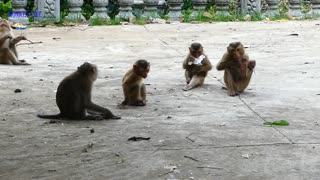Premium Only Content

Mating season in Bali Monkey forest - aggressive interactions between long-tailed macaques
Macaques live in social groups that contain three to 20 females, their offspring, and one or many males. In social groups of macaques, a clear dominance hierarchy is seen among females. These ranks remain stable throughout the female’s lifetime and also can be sustained through generations of matrilines.
Alpha males have a higher frequency of mating compared to their lower-ranking conspecifics. The increased success is due partially to his increased access to females and also due to female preference of an alpha male during periods of maximum fertility. Though females have a preference for alpha males, they do display promiscuous behavior. Through this behavior, females risk helping to rear a nonalpha offspring, yet benefit in two specific ways, both in regard to aggressive behavior.
Group living in all species is dependent on tolerance of other group members. In long-tailed macaques, successful social group living maintains postconflict resolution must occur. Usually, less dominant individuals lose to a higher-ranking individual when conflict arises. After the conflict has taken place, lower-ranking individuals tend to fear the winner of the conflict to a greater degree.
-
 4:15
4:15
WFTX
4 years agoBear mating season increasing sightings
20 -
 4:47
4:47
apdulaziz
4 years agoAttack between snake and monkey
301 -
 1:27:56
1:27:56
Glenn Greenwald
6 hours agoSemafor Editor Ben Smith on Epstein Saga; How do MAGA Supporters Really Feel About Trump's Foreign Policy? Eddington Movie Review: Reflections on 2020 | SYSTEM UPDATE #490
125K60 -
 2:13:20
2:13:20
megimu32
3 hours agoOTS: Infomercial Insanity | 80s-00s Gadgets That Sold Big (and Made Us Buy)
15.7K4 -
 LIVE
LIVE
Amish Zaku
4 hours agoA Celebration of Ozzy Osbourne's Life, Music, and Spirit
156 watching -
 48:41
48:41
The Mel K Show
5 hours agoMel K & Aaron Day | Wake up! Walking Blindly into Totalitarian Technocracy | 7-22-25
36.6K12 -
 1:05:20
1:05:20
BonginoReport
7 hours agoEpstein: From “Case Closed” to “To Be Continued” - Nightly Scroll w/ Hayley Caronia (Ep.95)
136K71 -
 1:40:54
1:40:54
Anthony Rogers
1 day agoEpisode 375 - Randy Valerio
7.68K2 -
 1:32:14
1:32:14
Kim Iversen
7 hours ago"Obama Belongs In Jail!" Tulsi Gabbard Exposes Entire Russiagate Hoax
114K118 -
 LIVE
LIVE
AlphaZeroOmega
3 hours ago $0.13 earnedHitman: ⚔ Ozzy Osbourne Tribute ⚔ | 🚨Rumble Studio Direct RTMP🚨
26 watching